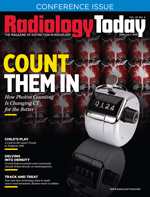 Fluoroscopy News: On the Move
Fluoroscopy News: On the Move
By Beth W. Orenstein
Radiology Today
Vol. 23 No. 4 P. 7
Fluoroscopy continues to meet the demand for high-precision, minimally invasive procedures.
The demand for minimally invasive surgeries is growing substantially. The reason: Minimally invasive surgeries promise lower risk of complications, reduced costs, a shorter recovery period, less pain, smaller incisions, and less scarring. Fluoroscopy, which provides real-time moving images for evaluation of soft and hard tissue conditions, is an indispensable tool for many high-precision interventional procedures, many of which are done minimally invasively.
While fluoroscopy’s origins date to the late 1800s, its use in medical imaging has taken off since the mid-1990s. In December 2021, Reportlinker.com issued a report that predicted the fluoroscopy market will continue to register significant growth in the coming years. The report attributed the anticipated growth in part to the demand for high-precision, minimally invasive procedures. Other factors that Reportlinker.com cited for substantial growth include a growing geriatric population, the prevalence of chronic diseases, and the increasing use of fluoroscopy in pain management.
Radiology Today speaks with Marco Riolfo, global marketing manager for digital radiography rooms at Carestream Health, about trends in fluoroscopy and its role in the future of imaging. Carestream’s DRX-Excel Plus is a dedicated system that combines fluoroscopy and DR for performing contrast exams as well as interventional procedures.
RT: What role is fluoroscopy playing in 2022? When is it the preferred imaging modality? And why then?
Riolfo: The role of fluoroscopy in 2022 will remain as it has been in the last few years: IR rooms (surgery), mobile fluoro systems (C-arm), and DR and fluoroscopy systems (dRF). Fluoroscopy is the preferred imaging modality when practitioners need to have access to motion imaging to study specific organ systems, such as gastrointestinal, urinary, and pulmonary, or for vascular procedures. It is also used to guide surgeons through specific procedures that require real-time needle location, catheter or stent placement, or bolus tracking, or simply to identify the area of intervention in real time. Simple motion studies in orthopedics also can utilize fluoroscopy.
RT: Access to patients is important in fluoroscopic imaging. What’s new in that respect?
Riolfo: An important key benefit of fluoroscopy is that it provides access to patients. There are three cornerstones to achieve high-quality and consistent X-ray image capture: positioning, technique, and collimation.
Positioning is the most important of the three. Many repeat images are due to positioning errors. When patients are scanned through a CT, they cannot be reached or positioned. The accessibility to patients allows fluoroscopy to be used for many more approaches to patient imaging than CT. In fact, this is leading to an important trend in fluoroscopic imaging—enabling better access to a patient to position for optimum image capture.
Here is how this is happening:
• Accessible table designs allow radiology technologists to work with a patient from both sides.
• Use of cameras helps with positioning and monitoring.
• Also, some companies are delivering fluoroscopic systems with a small footprint that can sit on a desktop. These allow use by hand surgeons, for example, in outpatient settings.
RT: Are there instances where fluoroscopy has been replaced by different imaging technology? If so, why?
Riolfo: CT imaging in recent years—due to COVID’s impact—has seen a significant increase in terms of procedures. This effect saturated the capacity of CTs and DR rooms in most facilities. Several advances in dRF systems have made them more attractive and able to alleviate some of this demand.
RT: What new roles do you see for fluoroscopy in the future? Why?
Riolfo: Fluoroscopy is seen as an enhancement of traditional radiography. Static images can become dynamic, and this will give additional information to the radiologists in terms of diagnostic content for specific pathologies linked to articulation movements, weight-bearing studies, etc. With advances in the sensitivity of flat panel detectors and pulse exposure technology, dose levels are much lower than in previous years, thus easing concerns about exposure levels. (Radiation dose from fluoroscopy is a concern because fluoroscopy-guided procedures are often technically difficult, resulting in exposure times of an hour or more. However, newer technology and greater awareness has helped to resolve the issue to some extent.)
RT: Anything else you want to add about today’s trends in fluoroscopy?
Riolfo: The advent of AI coupled with the innovations coming from dynamic detectors will allow manufacturers to look into new developments and systems capable of delivering better image quality with an even lower dose than what is possible today. Another trend that I see coming: some companies providing multiangle viewing, which will enable 3D imaging.
— Beth W. Orenstein is a freelance medical writer in Northampton, Pennsylvania. She is a regular contributor to Radiology Today.

